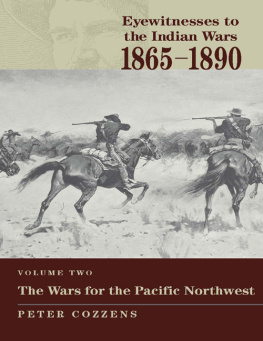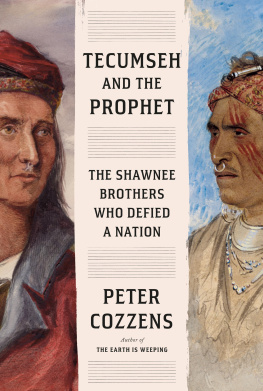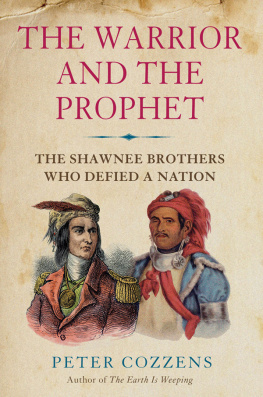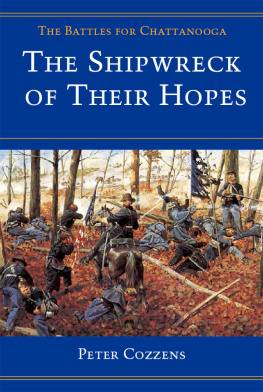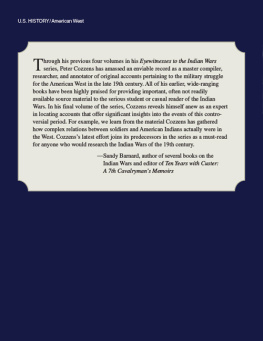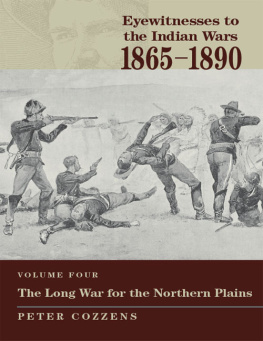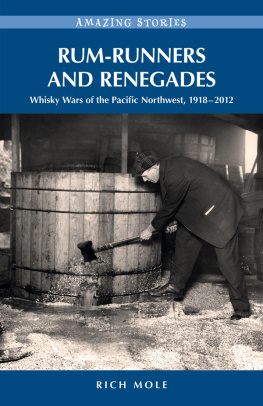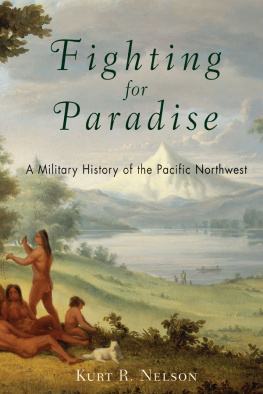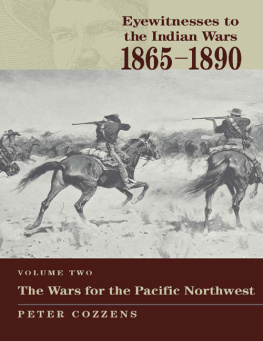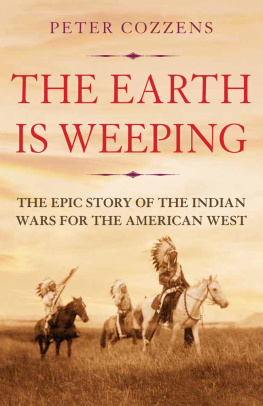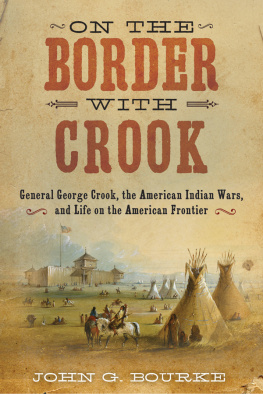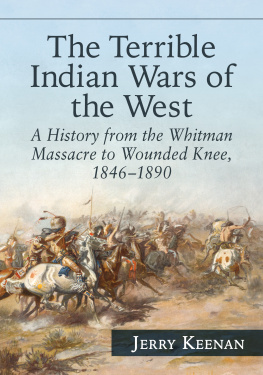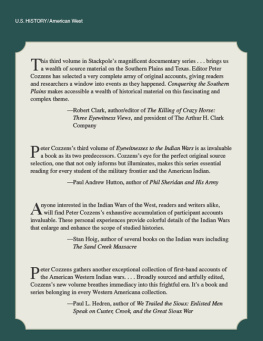ACKNOWLEDGMENTS
Continued service abroad on diplomatic assignment with the Department of State has posed unique challenges to my gathering the articles and other primary accounts found in Eyewitnesses to the Indian Wars, 18651890: The Wars for the Pacific Northwest. Without the help of those persons mentioned below, it would have been impossible.
My deepest thanks go to my mother for her many trips to the Wheaton (Illinois) Public Library, submitting OCLC requests and retrieving articles, and to the staff of the periodicals department of the Wheaton Public Library for their kindness and diligence in filling these requests.
Jerome A. Greene of the National Park Service provided helpful suggestions and guidance in the selection of sources pertaining to the Nez Perce War. I heartily recommend his Nez Perce Summer, 1877: The U.S. Army and the Nee-Me-Poo Crisis (Helena: Montana Historical Society, 2000), to anyone wishing to learn more about that fascinating and tragic conflict; it is, in my opinion, one of the very best studies of a frontier military campaign ever written.
My friend Scott Forsythe of the National Archives guided me to a number of sources and put me in contact with historians such as Jerry Greene.
Much of the material presented here I obtained during several visits to the Newberry Library in Chicago. The reference staff of that institution was most helpful on every occasion.
I also thank the following individuals for providing me with manuscripts from their collections and, where necessary, for permission to publish this material: Terry Abraham, head of special collections at the University of Idaho, Moscow; John A. Doerner, chief historian at the Little Big Horn National Monument, Crow Agency, Montana; David M. Hays, archivist and instructor at the University of Colorado, Boulder; Robert N. Matuozzi, manuscripts librarian at Washington State University, Pullman; Susan E. Snyder of the Bancroft Library, University of California, Berkeley; Robert G. Trujillo, head of special collections at Stanford University; and Brent Wagner, manuscripts librarian at the Denver Public Library.
My thanks go also to my copyeditor at Stackpole, Joyce Bond, for the excpetional work she did on the long and complex manuscript.
Finally, I thank my editor at Stackpole, Leigh Ann Berry, for her enthusiastic support of this project.
Fighting in the Sierras
ALBERT G. BRACKETT
United Service, n.s., 6, no. 5 (October 1891): 32128
A n Indian War is always a serious matter, as it generally breaks out suddenly and there is no telling how far reaching it may be in its effects. The sparse settlements are overrun and many individuals killed before any relief can be afforded.
The troubles in the states of Nevada and California in 1866 and 1867 have never been properly appreciated. Bold and fearless bands of savages roamed at will over large extents of country, murdering unsuspecting and helpless people and using the torch freely in the infant communities of the states mentioned. Taking advantage of the disturbed condition of the Union during the Civil War, the red men thought it the proper time to avenge their fancied wrongs and at the same time to add to their own wealth. For years they had watched the immigrants as they slowly toiled across the continent on their way to the new lands bordering on the Pacific Ocean and, having possessed themselves of good arms and a plentiful supply of ammunition, sought to arrest their progress, or at least to take from them what they had. Being in no way scrupulous about the means adopted to bring about this state of affairs, they swarmed on the thoroughfares and occupied the dark defiles.
The California and Nevada volunteers had rendered good service in keeping back the insolent foemen, and Lieutenant Colonel McDermit This act greatly incensed the California Volunteers, who were a superior body of men, utterly fearless and untiring. From that time forth they put forward their utmost efforts and spared no pains to find the savages, who mainly belonged to the Paiute and Snake tribes.
Upon the death of McDermit, Lt. Col. [Ambrose E.] Hooker, who was promoted to his place in the 2nd Regiment of California Cavalry Volunteers, took command of the District of Nevada, which he retained until mustered out The mountains of Nevada furnished ample hiding places, while the warm valleys were safe retreats during the cold winter season for the savages and their animals, as nearly all of them were mounted.
The care of the women and children is always a matter of great moment to the Indians while engaged on the warpath and gives them the greatest anxiety. An effective blow can always be administered to them by capturing their wives and little ones. There is no better place to conceal considerable bodies of people than the rocky gorges of the mountains, many caves of considerable dimensions being found among the great lava fields to be met in all directions. It must be borne in mind that these people had occupied this region for an indefinite period and were well acquainted with all of its secret recesses and handsome valleys. Food supplies of pine nuts, acorns, grass, seeds, and tule could be found easily, and tame cattle and horses made up the wealth of the red men. They had a fair supply of clothing, but from infancy Indians are not well clad and can endure a great degree of cold without much apparent suffering. They wear clothing as much for ornament as for actual use and upon going into battle like to strip off everything. Their tactics in war do not differ from those of their kindred farther to the eastward, they deeming it the height of folly to expose themselves openly to the bullets of their enemies. Every inequality of the ground is taken advantage of, as well as every root, tree, bush, rock, and shrub. They can conceal themselves behind the smallest objects.
The first action of any moment was fought by Capt. George D. Conrad with twenty-five men of Company B and twenty-five of Company I under Lieutenant Duncanall of the 2nd California Cavalry, who attacked the hostiles on the west side of Quinn's River, near Fish Creek, on January 11, 1866. This was quite a severe check upon the red men and showed them that the time had arrived when the whites were determined to avenge the wrongs done them on so many occasions.
Their loss caused them deep grief, and there was wailing through the mountain region. For the first time they began to realize the danger they were in, although none of them yet thought of coming in and giving themselves up and suing for peace. They possessed great resolution, and having retained the advantage in numerous small encounters with the settlers, thought this was but a temporary disadvantage and that in the next affair they would retrieve their fallen fortunes and times would continue as they had been before. In this they were mistaken and were obliged to receive still greater chastisement.
On February 15, 1866, Maj. Samuel P. Smith of the 2nd California Cavalry, with a body of troops made up of volunteer citizens, numbering in all eighty-one, encountered the savages near Rock Canyon in Nevada. A severe fight ensued in which 115 Indians were killed and nineteen captured. Private Austin of Company D was killed. Major Smith and Privates Resler, Grimshaw, Balta, and Rhuman of Company D, and Privates Mills and Smith of Company F were wounded. Maj. Henry B. J. Mellen, Captain Starr, and Lieutenant Robinson of the 2nd California Cavalry were with the detachment. Sixty horses which had been stolen from the settlers were recovered, and a large amount of Indian property was destroyed.
On account of the good conduct of Majors Smith and Mellen, they were subsequently appointed officers in the Regular Army, the former a captain in the 8th, and the latter a lieutenant in the 6th Cavalry. This was a very important affair and reflected great credit upon the troops engaged. At one time it was feared that the whole detachment would be cut off, but a vigorous onslaught led by Major Smith in person gave the whites possession of the strong grounds occupied by the enemy, who were soon put to flight with the losses above mentioned. The foemen were considerably disheartened by this defeat, which was a severe one.
Next page
